Brand Management Report: Strategies for Brand Equity and Portfolio
VerifiedAdded on 2020/11/12
|18
|5931
|381
Report
AI Summary
This report provides a comprehensive analysis of brand management strategies, focusing on the case of Marks and Spencer. It begins with an introduction to brand management, defining key concepts such as brand equity and its importance for organizational success. The report then delves into the strategies for building and managing a brand over time, including the role of the marketing department, competitive analysis, and the use of the Keller Customer-Based Brand Equity (CBBE) model. The report also examines brand extension, reinforcement, and revitalization strategies. Furthermore, it analyzes Marks and Spencer's brand portfolio strategy, illustrating the hierarchy management of brands using models like the branded house and house of brands. The report assesses the strategies used for managing brand equity, including brand loyalty and value, and concludes with a discussion of overcoming brand crises. The report covers various aspects of branding, from building customer relationships to maintaining brand value in a competitive market.
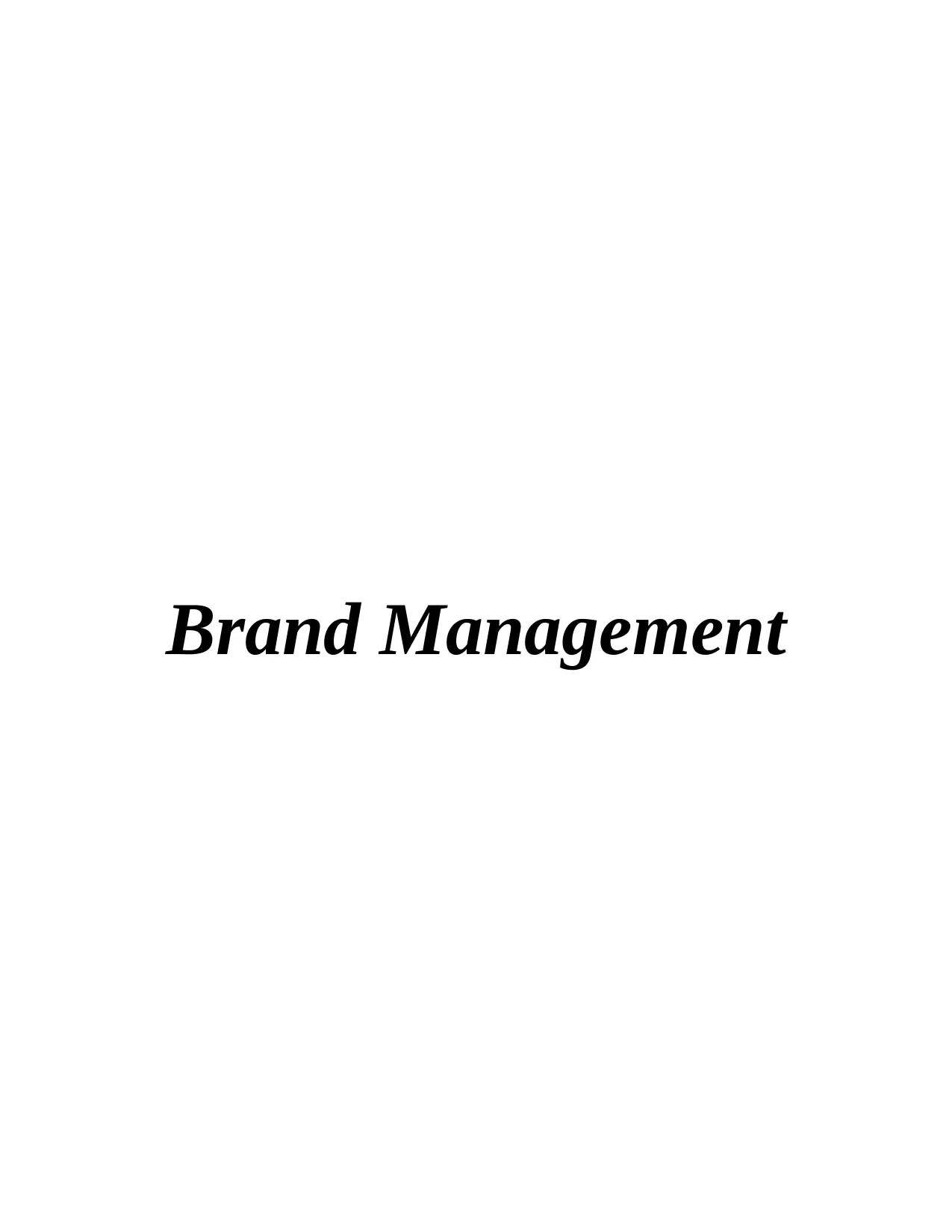
Brand Management
Paraphrase This Document
Need a fresh take? Get an instant paraphrase of this document with our AI Paraphraser
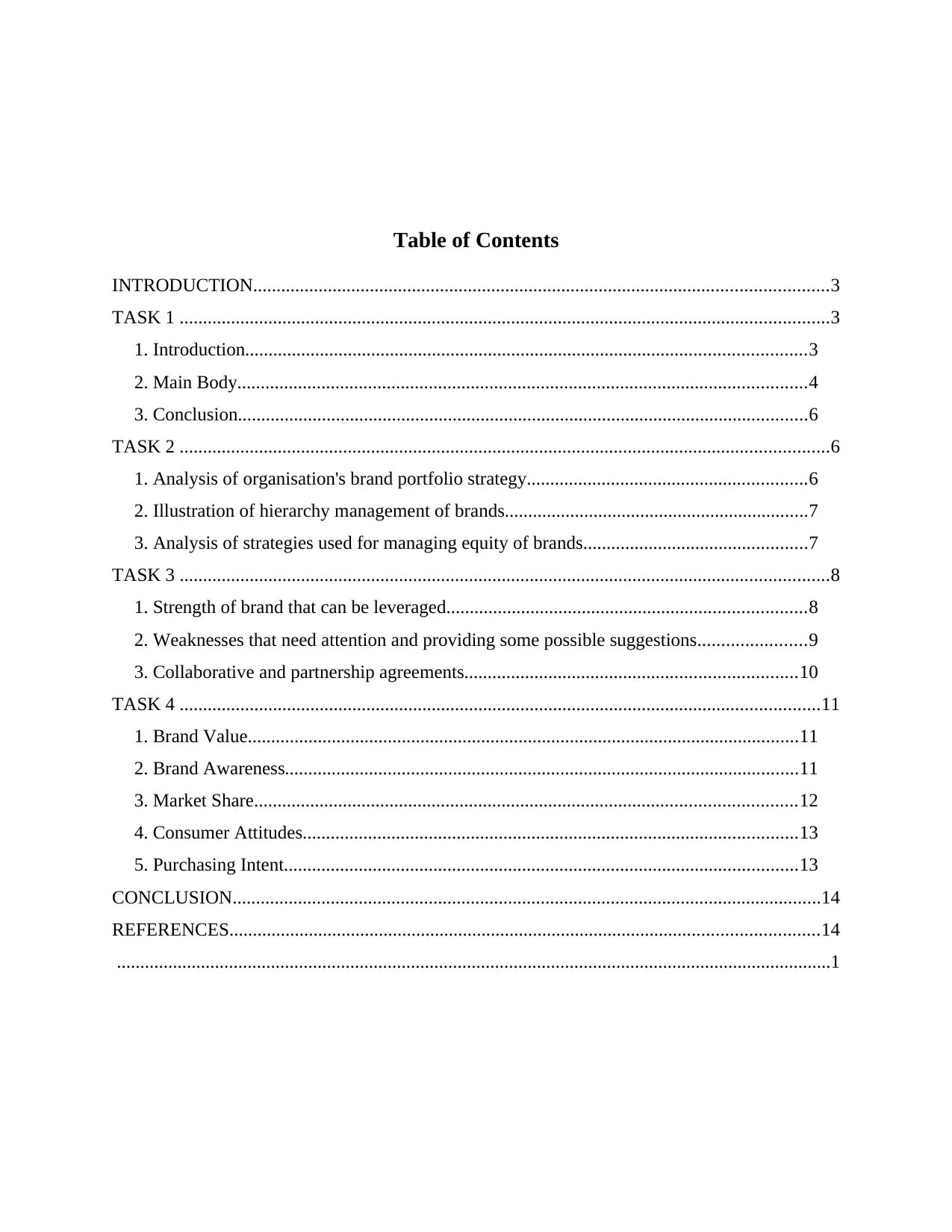
Table of Contents
INTRODUCTION...........................................................................................................................3
TASK 1 ...........................................................................................................................................3
1. Introduction........................................................................................................................3
2. Main Body..........................................................................................................................4
3. Conclusion..........................................................................................................................6
TASK 2 ...........................................................................................................................................6
1. Analysis of organisation's brand portfolio strategy............................................................6
2. Illustration of hierarchy management of brands.................................................................7
3. Analysis of strategies used for managing equity of brands................................................7
TASK 3 ...........................................................................................................................................8
1. Strength of brand that can be leveraged.............................................................................8
2. Weaknesses that need attention and providing some possible suggestions.......................9
3. Collaborative and partnership agreements.......................................................................10
TASK 4 .........................................................................................................................................11
1. Brand Value......................................................................................................................11
2. Brand Awareness..............................................................................................................11
3. Market Share....................................................................................................................12
4. Consumer Attitudes..........................................................................................................13
5. Purchasing Intent..............................................................................................................13
CONCLUSION..............................................................................................................................14
REFERENCES..............................................................................................................................14
.........................................................................................................................................................1
INTRODUCTION...........................................................................................................................3
TASK 1 ...........................................................................................................................................3
1. Introduction........................................................................................................................3
2. Main Body..........................................................................................................................4
3. Conclusion..........................................................................................................................6
TASK 2 ...........................................................................................................................................6
1. Analysis of organisation's brand portfolio strategy............................................................6
2. Illustration of hierarchy management of brands.................................................................7
3. Analysis of strategies used for managing equity of brands................................................7
TASK 3 ...........................................................................................................................................8
1. Strength of brand that can be leveraged.............................................................................8
2. Weaknesses that need attention and providing some possible suggestions.......................9
3. Collaborative and partnership agreements.......................................................................10
TASK 4 .........................................................................................................................................11
1. Brand Value......................................................................................................................11
2. Brand Awareness..............................................................................................................11
3. Market Share....................................................................................................................12
4. Consumer Attitudes..........................................................................................................13
5. Purchasing Intent..............................................................................................................13
CONCLUSION..............................................................................................................................14
REFERENCES..............................................................................................................................14
.........................................................................................................................................................1
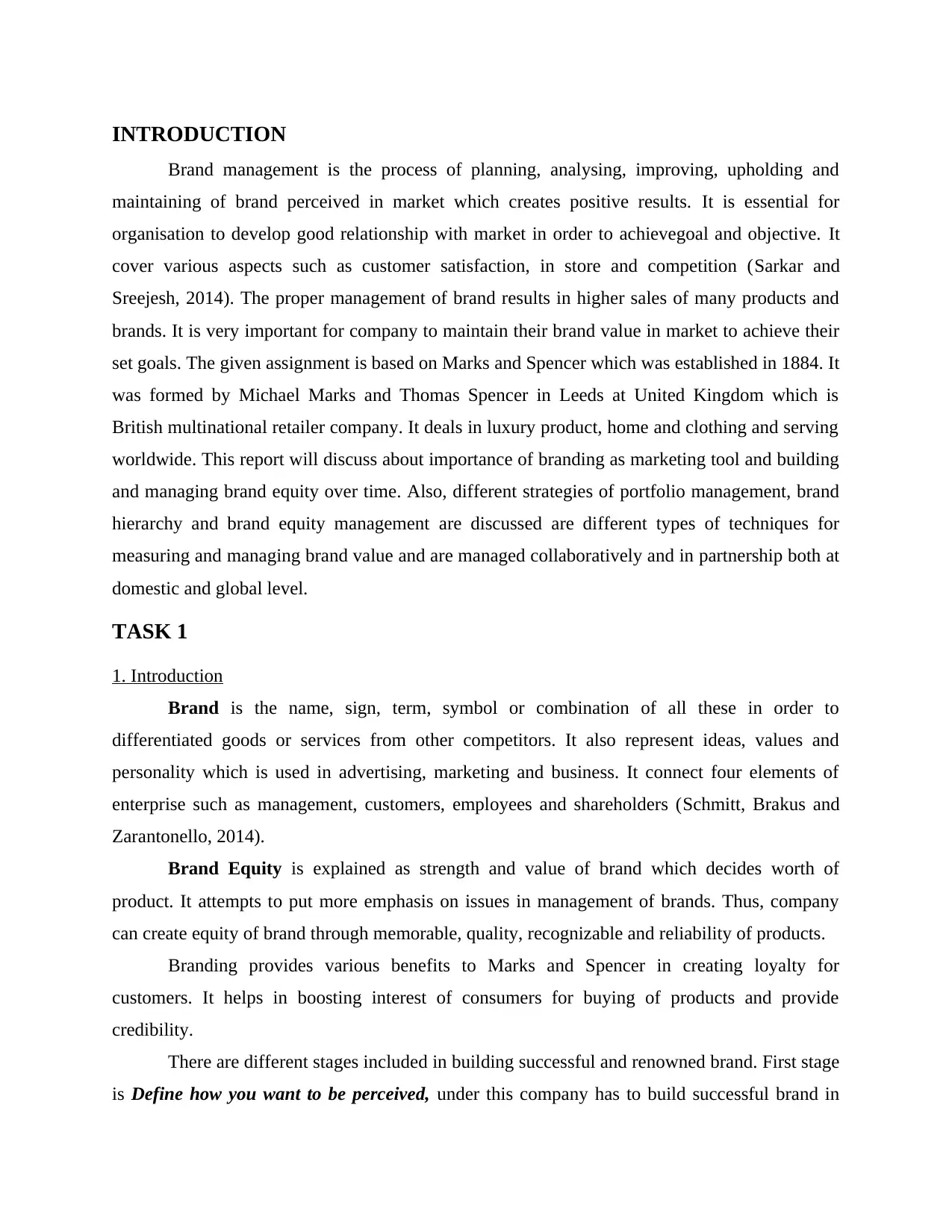
INTRODUCTION
Brand management is the process of planning, analysing, improving, upholding and
maintaining of brand perceived in market which creates positive results. It is essential for
organisation to develop good relationship with market in order to achievegoal and objective. It
cover various aspects such as customer satisfaction, in store and competition (Sarkar and
Sreejesh, 2014). The proper management of brand results in higher sales of many products and
brands. It is very important for company to maintain their brand value in market to achieve their
set goals. The given assignment is based on Marks and Spencer which was established in 1884. It
was formed by Michael Marks and Thomas Spencer in Leeds at United Kingdom which is
British multinational retailer company. It deals in luxury product, home and clothing and serving
worldwide. This report will discuss about importance of branding as marketing tool and building
and managing brand equity over time. Also, different strategies of portfolio management, brand
hierarchy and brand equity management are discussed are different types of techniques for
measuring and managing brand value and are managed collaboratively and in partnership both at
domestic and global level.
TASK 1
1. Introduction
Brand is the name, sign, term, symbol or combination of all these in order to
differentiated goods or services from other competitors. It also represent ideas, values and
personality which is used in advertising, marketing and business. It connect four elements of
enterprise such as management, customers, employees and shareholders (Schmitt, Brakus and
Zarantonello, 2014).
Brand Equity is explained as strength and value of brand which decides worth of
product. It attempts to put more emphasis on issues in management of brands. Thus, company
can create equity of brand through memorable, quality, recognizable and reliability of products.
Branding provides various benefits to Marks and Spencer in creating loyalty for
customers. It helps in boosting interest of consumers for buying of products and provide
credibility.
There are different stages included in building successful and renowned brand. First stage
is Define how you want to be perceived, under this company has to build successful brand in
Brand management is the process of planning, analysing, improving, upholding and
maintaining of brand perceived in market which creates positive results. It is essential for
organisation to develop good relationship with market in order to achievegoal and objective. It
cover various aspects such as customer satisfaction, in store and competition (Sarkar and
Sreejesh, 2014). The proper management of brand results in higher sales of many products and
brands. It is very important for company to maintain their brand value in market to achieve their
set goals. The given assignment is based on Marks and Spencer which was established in 1884. It
was formed by Michael Marks and Thomas Spencer in Leeds at United Kingdom which is
British multinational retailer company. It deals in luxury product, home and clothing and serving
worldwide. This report will discuss about importance of branding as marketing tool and building
and managing brand equity over time. Also, different strategies of portfolio management, brand
hierarchy and brand equity management are discussed are different types of techniques for
measuring and managing brand value and are managed collaboratively and in partnership both at
domestic and global level.
TASK 1
1. Introduction
Brand is the name, sign, term, symbol or combination of all these in order to
differentiated goods or services from other competitors. It also represent ideas, values and
personality which is used in advertising, marketing and business. It connect four elements of
enterprise such as management, customers, employees and shareholders (Schmitt, Brakus and
Zarantonello, 2014).
Brand Equity is explained as strength and value of brand which decides worth of
product. It attempts to put more emphasis on issues in management of brands. Thus, company
can create equity of brand through memorable, quality, recognizable and reliability of products.
Branding provides various benefits to Marks and Spencer in creating loyalty for
customers. It helps in boosting interest of consumers for buying of products and provide
credibility.
There are different stages included in building successful and renowned brand. First stage
is Define how you want to be perceived, under this company has to build successful brand in
⊘ This is a preview!⊘
Do you want full access?
Subscribe today to unlock all pages.

Trusted by 1+ million students worldwide
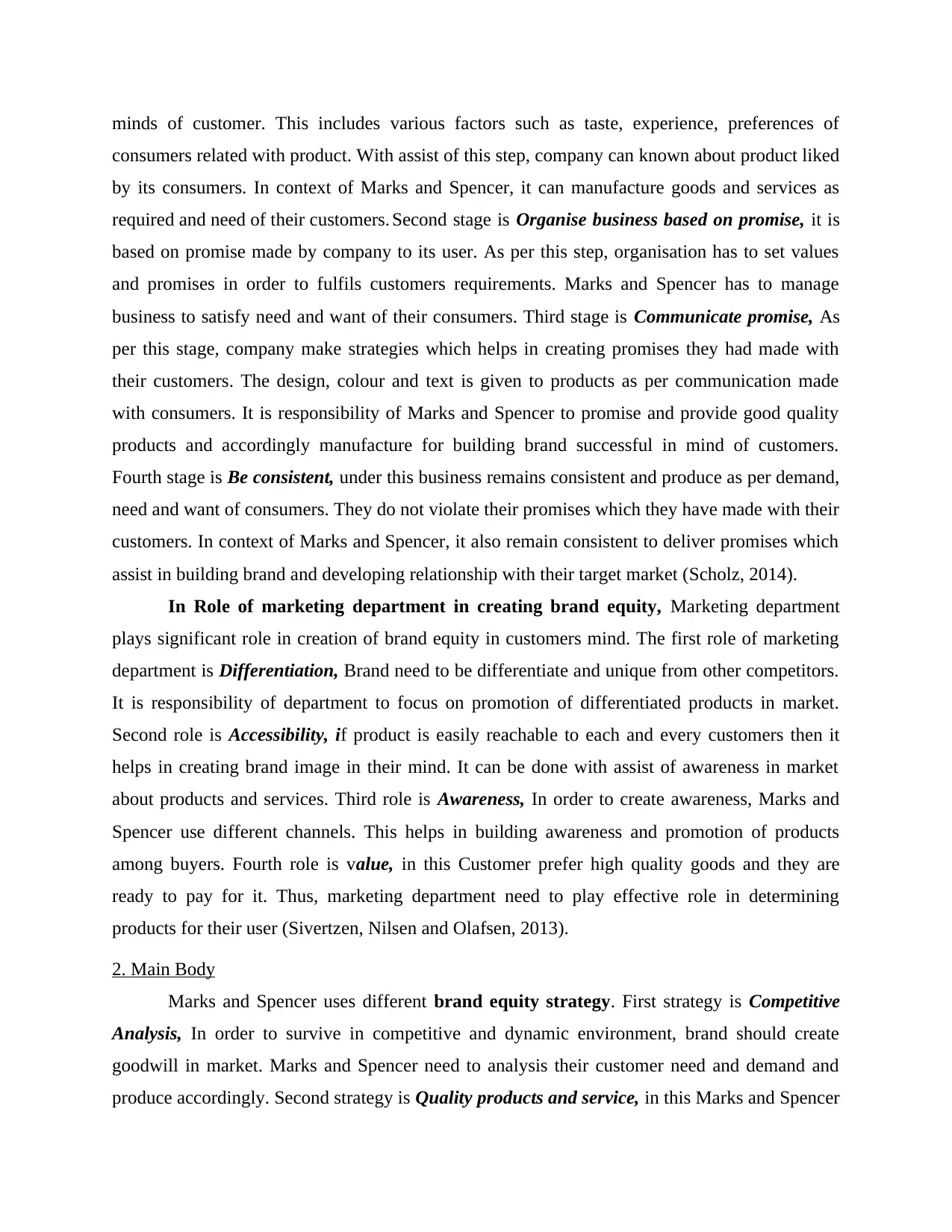
minds of customer. This includes various factors such as taste, experience, preferences of
consumers related with product. With assist of this step, company can known about product liked
by its consumers. In context of Marks and Spencer, it can manufacture goods and services as
required and need of their customers. Second stage is Organise business based on promise, it is
based on promise made by company to its user. As per this step, organisation has to set values
and promises in order to fulfils customers requirements. Marks and Spencer has to manage
business to satisfy need and want of their consumers. Third stage is Communicate promise, As
per this stage, company make strategies which helps in creating promises they had made with
their customers. The design, colour and text is given to products as per communication made
with consumers. It is responsibility of Marks and Spencer to promise and provide good quality
products and accordingly manufacture for building brand successful in mind of customers.
Fourth stage is Be consistent, under this business remains consistent and produce as per demand,
need and want of consumers. They do not violate their promises which they have made with their
customers. In context of Marks and Spencer, it also remain consistent to deliver promises which
assist in building brand and developing relationship with their target market (Scholz, 2014).
In Role of marketing department in creating brand equity, Marketing department
plays significant role in creation of brand equity in customers mind. The first role of marketing
department is Differentiation, Brand need to be differentiate and unique from other competitors.
It is responsibility of department to focus on promotion of differentiated products in market.
Second role is Accessibility, if product is easily reachable to each and every customers then it
helps in creating brand image in their mind. It can be done with assist of awareness in market
about products and services. Third role is Awareness, In order to create awareness, Marks and
Spencer use different channels. This helps in building awareness and promotion of products
among buyers. Fourth role is value, in this Customer prefer high quality goods and they are
ready to pay for it. Thus, marketing department need to play effective role in determining
products for their user (Sivertzen, Nilsen and Olafsen, 2013).
2. Main Body
Marks and Spencer uses different brand equity strategy. First strategy is Competitive
Analysis, In order to survive in competitive and dynamic environment, brand should create
goodwill in market. Marks and Spencer need to analysis their customer need and demand and
produce accordingly. Second strategy is Quality products and service, in this Marks and Spencer
consumers related with product. With assist of this step, company can known about product liked
by its consumers. In context of Marks and Spencer, it can manufacture goods and services as
required and need of their customers. Second stage is Organise business based on promise, it is
based on promise made by company to its user. As per this step, organisation has to set values
and promises in order to fulfils customers requirements. Marks and Spencer has to manage
business to satisfy need and want of their consumers. Third stage is Communicate promise, As
per this stage, company make strategies which helps in creating promises they had made with
their customers. The design, colour and text is given to products as per communication made
with consumers. It is responsibility of Marks and Spencer to promise and provide good quality
products and accordingly manufacture for building brand successful in mind of customers.
Fourth stage is Be consistent, under this business remains consistent and produce as per demand,
need and want of consumers. They do not violate their promises which they have made with their
customers. In context of Marks and Spencer, it also remain consistent to deliver promises which
assist in building brand and developing relationship with their target market (Scholz, 2014).
In Role of marketing department in creating brand equity, Marketing department
plays significant role in creation of brand equity in customers mind. The first role of marketing
department is Differentiation, Brand need to be differentiate and unique from other competitors.
It is responsibility of department to focus on promotion of differentiated products in market.
Second role is Accessibility, if product is easily reachable to each and every customers then it
helps in creating brand image in their mind. It can be done with assist of awareness in market
about products and services. Third role is Awareness, In order to create awareness, Marks and
Spencer use different channels. This helps in building awareness and promotion of products
among buyers. Fourth role is value, in this Customer prefer high quality goods and they are
ready to pay for it. Thus, marketing department need to play effective role in determining
products for their user (Sivertzen, Nilsen and Olafsen, 2013).
2. Main Body
Marks and Spencer uses different brand equity strategy. First strategy is Competitive
Analysis, In order to survive in competitive and dynamic environment, brand should create
goodwill in market. Marks and Spencer need to analysis their customer need and demand and
produce accordingly. Second strategy is Quality products and service, in this Marks and Spencer
Paraphrase This Document
Need a fresh take? Get an instant paraphrase of this document with our AI Paraphraser
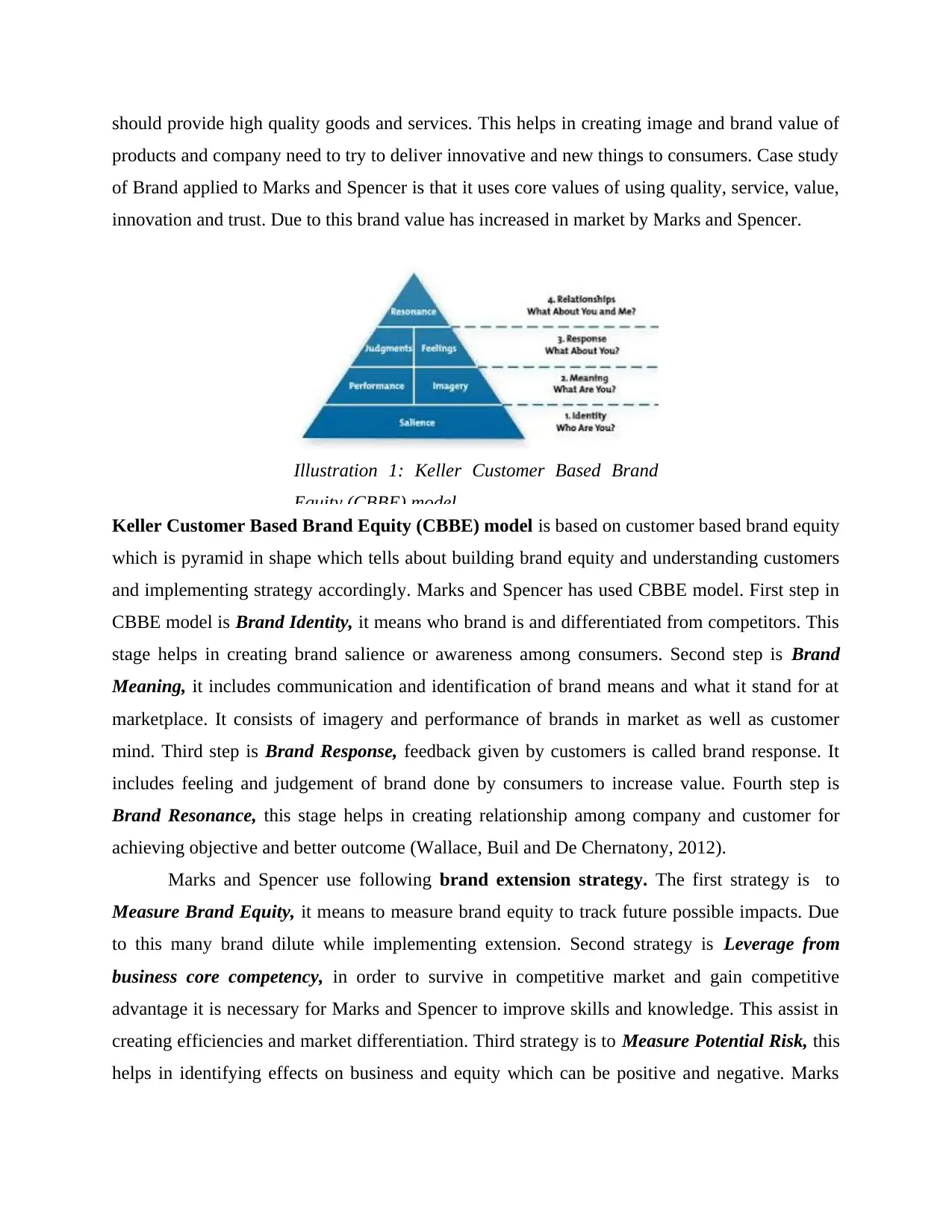
should provide high quality goods and services. This helps in creating image and brand value of
products and company need to try to deliver innovative and new things to consumers. Case study
of Brand applied to Marks and Spencer is that it uses core values of using quality, service, value,
innovation and trust. Due to this brand value has increased in market by Marks and Spencer.
Keller Customer Based Brand Equity (CBBE) model is based on customer based brand equity
which is pyramid in shape which tells about building brand equity and understanding customers
and implementing strategy accordingly. Marks and Spencer has used CBBE model. First step in
CBBE model is Brand Identity, it means who brand is and differentiated from competitors. This
stage helps in creating brand salience or awareness among consumers. Second step is Brand
Meaning, it includes communication and identification of brand means and what it stand for at
marketplace. It consists of imagery and performance of brands in market as well as customer
mind. Third step is Brand Response, feedback given by customers is called brand response. It
includes feeling and judgement of brand done by consumers to increase value. Fourth step is
Brand Resonance, this stage helps in creating relationship among company and customer for
achieving objective and better outcome (Wallace, Buil and De Chernatony, 2012).
Marks and Spencer use following brand extension strategy. The first strategy is to
Measure Brand Equity, it means to measure brand equity to track future possible impacts. Due
to this many brand dilute while implementing extension. Second strategy is Leverage from
business core competency, in order to survive in competitive market and gain competitive
advantage it is necessary for Marks and Spencer to improve skills and knowledge. This assist in
creating efficiencies and market differentiation. Third strategy is to Measure Potential Risk, this
helps in identifying effects on business and equity which can be positive and negative. Marks
Illustration 1: Keller Customer Based Brand
Equity (CBBE) model
products and company need to try to deliver innovative and new things to consumers. Case study
of Brand applied to Marks and Spencer is that it uses core values of using quality, service, value,
innovation and trust. Due to this brand value has increased in market by Marks and Spencer.
Keller Customer Based Brand Equity (CBBE) model is based on customer based brand equity
which is pyramid in shape which tells about building brand equity and understanding customers
and implementing strategy accordingly. Marks and Spencer has used CBBE model. First step in
CBBE model is Brand Identity, it means who brand is and differentiated from competitors. This
stage helps in creating brand salience or awareness among consumers. Second step is Brand
Meaning, it includes communication and identification of brand means and what it stand for at
marketplace. It consists of imagery and performance of brands in market as well as customer
mind. Third step is Brand Response, feedback given by customers is called brand response. It
includes feeling and judgement of brand done by consumers to increase value. Fourth step is
Brand Resonance, this stage helps in creating relationship among company and customer for
achieving objective and better outcome (Wallace, Buil and De Chernatony, 2012).
Marks and Spencer use following brand extension strategy. The first strategy is to
Measure Brand Equity, it means to measure brand equity to track future possible impacts. Due
to this many brand dilute while implementing extension. Second strategy is Leverage from
business core competency, in order to survive in competitive market and gain competitive
advantage it is necessary for Marks and Spencer to improve skills and knowledge. This assist in
creating efficiencies and market differentiation. Third strategy is to Measure Potential Risk, this
helps in identifying effects on business and equity which can be positive and negative. Marks
Illustration 1: Keller Customer Based Brand
Equity (CBBE) model
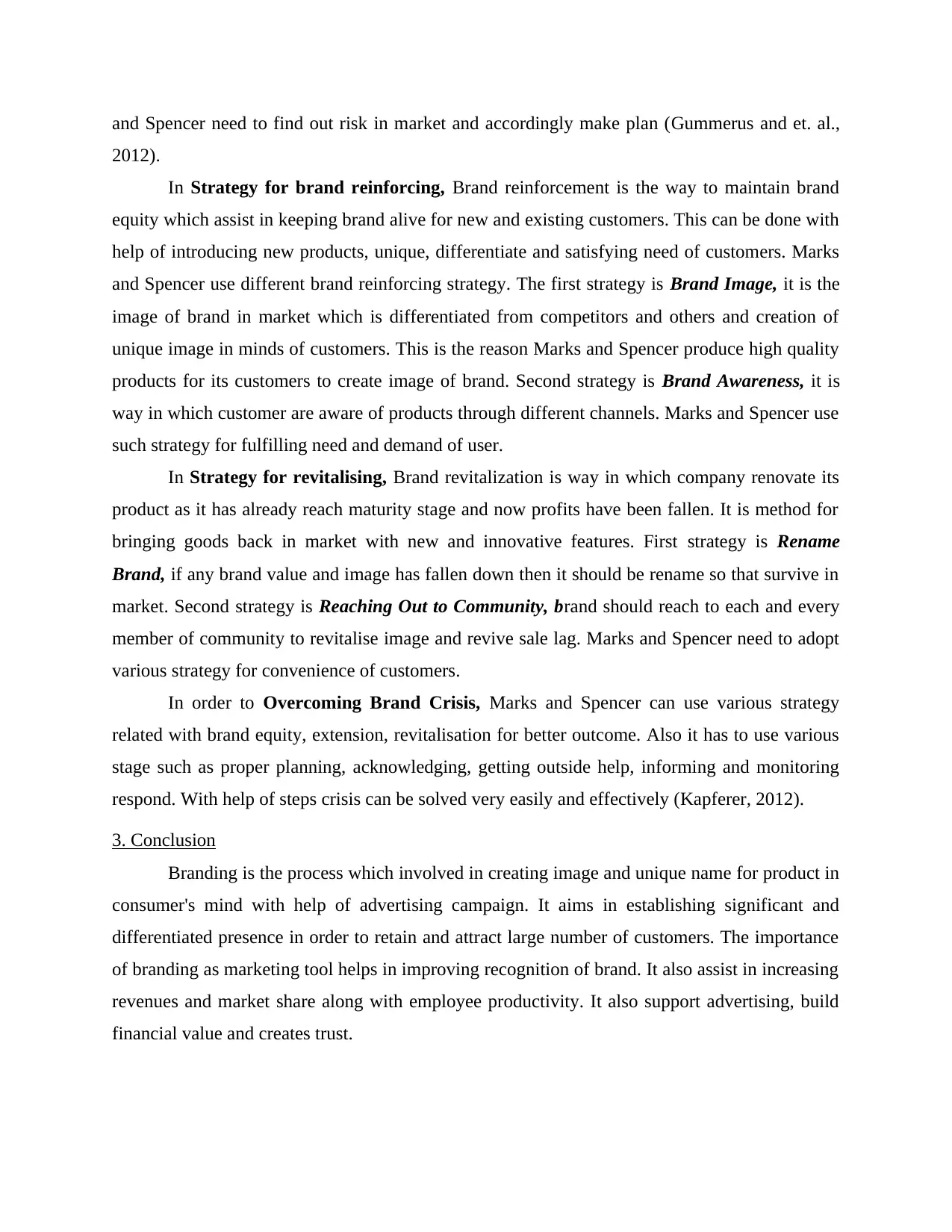
and Spencer need to find out risk in market and accordingly make plan (Gummerus and et. al.,
2012).
In Strategy for brand reinforcing, Brand reinforcement is the way to maintain brand
equity which assist in keeping brand alive for new and existing customers. This can be done with
help of introducing new products, unique, differentiate and satisfying need of customers. Marks
and Spencer use different brand reinforcing strategy. The first strategy is Brand Image, it is the
image of brand in market which is differentiated from competitors and others and creation of
unique image in minds of customers. This is the reason Marks and Spencer produce high quality
products for its customers to create image of brand. Second strategy is Brand Awareness, it is
way in which customer are aware of products through different channels. Marks and Spencer use
such strategy for fulfilling need and demand of user.
In Strategy for revitalising, Brand revitalization is way in which company renovate its
product as it has already reach maturity stage and now profits have been fallen. It is method for
bringing goods back in market with new and innovative features. First strategy is Rename
Brand, if any brand value and image has fallen down then it should be rename so that survive in
market. Second strategy is Reaching Out to Community, brand should reach to each and every
member of community to revitalise image and revive sale lag. Marks and Spencer need to adopt
various strategy for convenience of customers.
In order to Overcoming Brand Crisis, Marks and Spencer can use various strategy
related with brand equity, extension, revitalisation for better outcome. Also it has to use various
stage such as proper planning, acknowledging, getting outside help, informing and monitoring
respond. With help of steps crisis can be solved very easily and effectively (Kapferer, 2012).
3. Conclusion
Branding is the process which involved in creating image and unique name for product in
consumer's mind with help of advertising campaign. It aims in establishing significant and
differentiated presence in order to retain and attract large number of customers. The importance
of branding as marketing tool helps in improving recognition of brand. It also assist in increasing
revenues and market share along with employee productivity. It also support advertising, build
financial value and creates trust.
2012).
In Strategy for brand reinforcing, Brand reinforcement is the way to maintain brand
equity which assist in keeping brand alive for new and existing customers. This can be done with
help of introducing new products, unique, differentiate and satisfying need of customers. Marks
and Spencer use different brand reinforcing strategy. The first strategy is Brand Image, it is the
image of brand in market which is differentiated from competitors and others and creation of
unique image in minds of customers. This is the reason Marks and Spencer produce high quality
products for its customers to create image of brand. Second strategy is Brand Awareness, it is
way in which customer are aware of products through different channels. Marks and Spencer use
such strategy for fulfilling need and demand of user.
In Strategy for revitalising, Brand revitalization is way in which company renovate its
product as it has already reach maturity stage and now profits have been fallen. It is method for
bringing goods back in market with new and innovative features. First strategy is Rename
Brand, if any brand value and image has fallen down then it should be rename so that survive in
market. Second strategy is Reaching Out to Community, brand should reach to each and every
member of community to revitalise image and revive sale lag. Marks and Spencer need to adopt
various strategy for convenience of customers.
In order to Overcoming Brand Crisis, Marks and Spencer can use various strategy
related with brand equity, extension, revitalisation for better outcome. Also it has to use various
stage such as proper planning, acknowledging, getting outside help, informing and monitoring
respond. With help of steps crisis can be solved very easily and effectively (Kapferer, 2012).
3. Conclusion
Branding is the process which involved in creating image and unique name for product in
consumer's mind with help of advertising campaign. It aims in establishing significant and
differentiated presence in order to retain and attract large number of customers. The importance
of branding as marketing tool helps in improving recognition of brand. It also assist in increasing
revenues and market share along with employee productivity. It also support advertising, build
financial value and creates trust.
⊘ This is a preview!⊘
Do you want full access?
Subscribe today to unlock all pages.

Trusted by 1+ million students worldwide
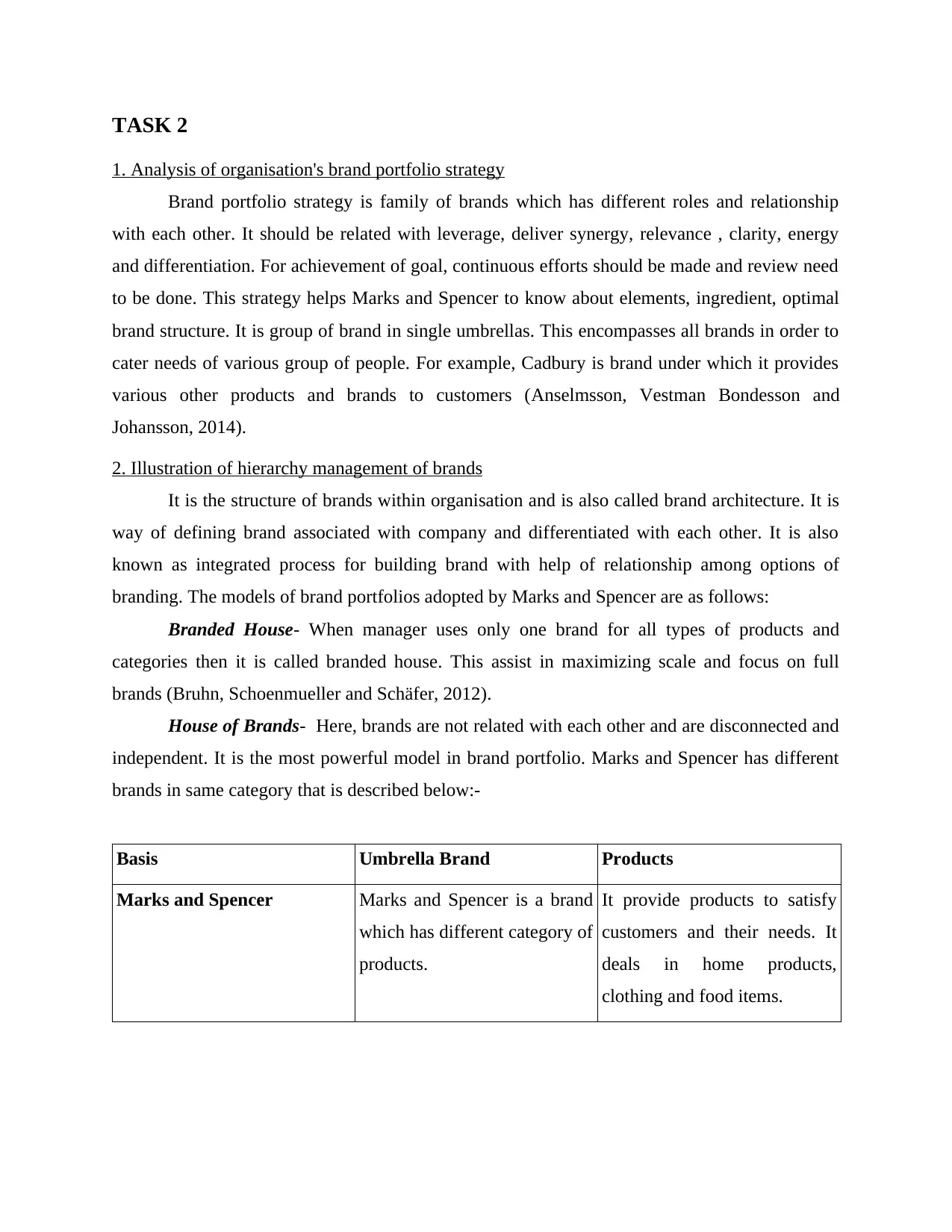
TASK 2
1. Analysis of organisation's brand portfolio strategy
Brand portfolio strategy is family of brands which has different roles and relationship
with each other. It should be related with leverage, deliver synergy, relevance , clarity, energy
and differentiation. For achievement of goal, continuous efforts should be made and review need
to be done. This strategy helps Marks and Spencer to know about elements, ingredient, optimal
brand structure. It is group of brand in single umbrellas. This encompasses all brands in order to
cater needs of various group of people. For example, Cadbury is brand under which it provides
various other products and brands to customers (Anselmsson, Vestman Bondesson and
Johansson, 2014).
2. Illustration of hierarchy management of brands
It is the structure of brands within organisation and is also called brand architecture. It is
way of defining brand associated with company and differentiated with each other. It is also
known as integrated process for building brand with help of relationship among options of
branding. The models of brand portfolios adopted by Marks and Spencer are as follows:
Branded House- When manager uses only one brand for all types of products and
categories then it is called branded house. This assist in maximizing scale and focus on full
brands (Bruhn, Schoenmueller and Schäfer, 2012).
House of Brands- Here, brands are not related with each other and are disconnected and
independent. It is the most powerful model in brand portfolio. Marks and Spencer has different
brands in same category that is described below:-
Basis Umbrella Brand Products
Marks and Spencer Marks and Spencer is a brand
which has different category of
products.
It provide products to satisfy
customers and their needs. It
deals in home products,
clothing and food items.
1. Analysis of organisation's brand portfolio strategy
Brand portfolio strategy is family of brands which has different roles and relationship
with each other. It should be related with leverage, deliver synergy, relevance , clarity, energy
and differentiation. For achievement of goal, continuous efforts should be made and review need
to be done. This strategy helps Marks and Spencer to know about elements, ingredient, optimal
brand structure. It is group of brand in single umbrellas. This encompasses all brands in order to
cater needs of various group of people. For example, Cadbury is brand under which it provides
various other products and brands to customers (Anselmsson, Vestman Bondesson and
Johansson, 2014).
2. Illustration of hierarchy management of brands
It is the structure of brands within organisation and is also called brand architecture. It is
way of defining brand associated with company and differentiated with each other. It is also
known as integrated process for building brand with help of relationship among options of
branding. The models of brand portfolios adopted by Marks and Spencer are as follows:
Branded House- When manager uses only one brand for all types of products and
categories then it is called branded house. This assist in maximizing scale and focus on full
brands (Bruhn, Schoenmueller and Schäfer, 2012).
House of Brands- Here, brands are not related with each other and are disconnected and
independent. It is the most powerful model in brand portfolio. Marks and Spencer has different
brands in same category that is described below:-
Basis Umbrella Brand Products
Marks and Spencer Marks and Spencer is a brand
which has different category of
products.
It provide products to satisfy
customers and their needs. It
deals in home products,
clothing and food items.
Paraphrase This Document
Need a fresh take? Get an instant paraphrase of this document with our AI Paraphraser
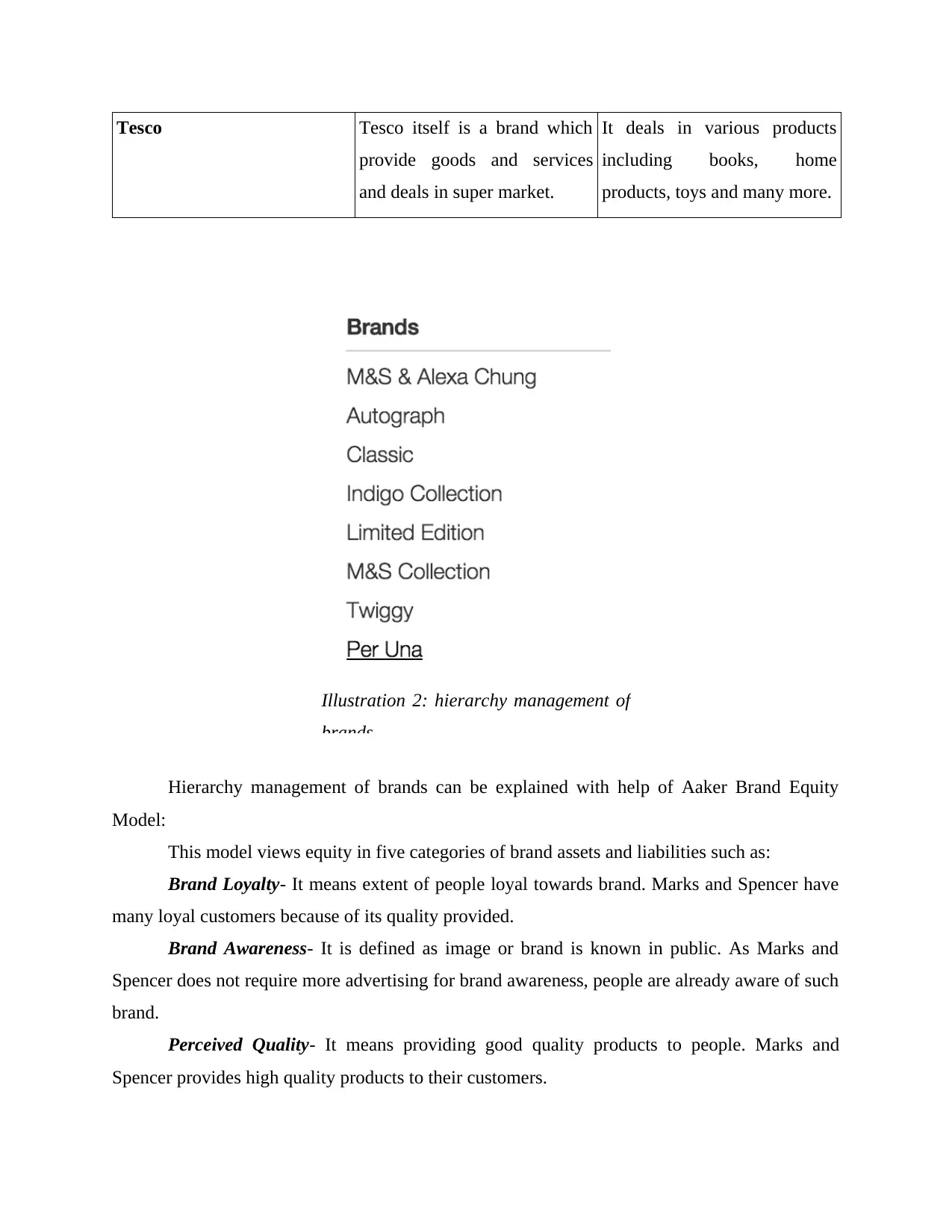
Tesco Tesco itself is a brand which
provide goods and services
and deals in super market.
It deals in various products
including books, home
products, toys and many more.
Hierarchy management of brands can be explained with help of Aaker Brand Equity
Model:
This model views equity in five categories of brand assets and liabilities such as:
Brand Loyalty- It means extent of people loyal towards brand. Marks and Spencer have
many loyal customers because of its quality provided.
Brand Awareness- It is defined as image or brand is known in public. As Marks and
Spencer does not require more advertising for brand awareness, people are already aware of such
brand.
Perceived Quality- It means providing good quality products to people. Marks and
Spencer provides high quality products to their customers.
Illustration 2: hierarchy management of
brands
provide goods and services
and deals in super market.
It deals in various products
including books, home
products, toys and many more.
Hierarchy management of brands can be explained with help of Aaker Brand Equity
Model:
This model views equity in five categories of brand assets and liabilities such as:
Brand Loyalty- It means extent of people loyal towards brand. Marks and Spencer have
many loyal customers because of its quality provided.
Brand Awareness- It is defined as image or brand is known in public. As Marks and
Spencer does not require more advertising for brand awareness, people are already aware of such
brand.
Perceived Quality- It means providing good quality products to people. Marks and
Spencer provides high quality products to their customers.
Illustration 2: hierarchy management of
brands
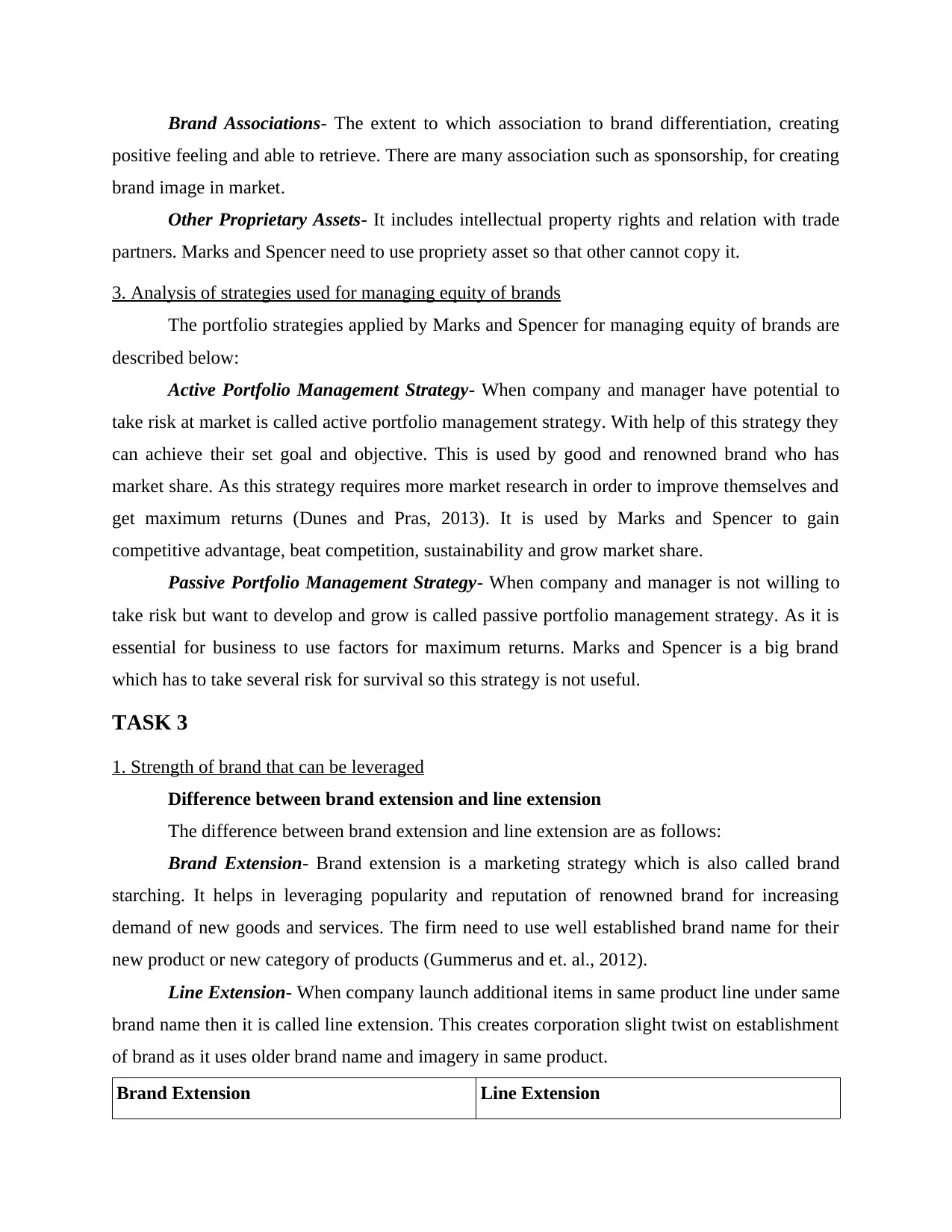
Brand Associations- The extent to which association to brand differentiation, creating
positive feeling and able to retrieve. There are many association such as sponsorship, for creating
brand image in market.
Other Proprietary Assets- It includes intellectual property rights and relation with trade
partners. Marks and Spencer need to use propriety asset so that other cannot copy it.
3. Analysis of strategies used for managing equity of brands
The portfolio strategies applied by Marks and Spencer for managing equity of brands are
described below:
Active Portfolio Management Strategy- When company and manager have potential to
take risk at market is called active portfolio management strategy. With help of this strategy they
can achieve their set goal and objective. This is used by good and renowned brand who has
market share. As this strategy requires more market research in order to improve themselves and
get maximum returns (Dunes and Pras, 2013). It is used by Marks and Spencer to gain
competitive advantage, beat competition, sustainability and grow market share.
Passive Portfolio Management Strategy- When company and manager is not willing to
take risk but want to develop and grow is called passive portfolio management strategy. As it is
essential for business to use factors for maximum returns. Marks and Spencer is a big brand
which has to take several risk for survival so this strategy is not useful.
TASK 3
1. Strength of brand that can be leveraged
Difference between brand extension and line extension
The difference between brand extension and line extension are as follows:
Brand Extension- Brand extension is a marketing strategy which is also called brand
starching. It helps in leveraging popularity and reputation of renowned brand for increasing
demand of new goods and services. The firm need to use well established brand name for their
new product or new category of products (Gummerus and et. al., 2012).
Line Extension- When company launch additional items in same product line under same
brand name then it is called line extension. This creates corporation slight twist on establishment
of brand as it uses older brand name and imagery in same product.
Brand Extension Line Extension
positive feeling and able to retrieve. There are many association such as sponsorship, for creating
brand image in market.
Other Proprietary Assets- It includes intellectual property rights and relation with trade
partners. Marks and Spencer need to use propriety asset so that other cannot copy it.
3. Analysis of strategies used for managing equity of brands
The portfolio strategies applied by Marks and Spencer for managing equity of brands are
described below:
Active Portfolio Management Strategy- When company and manager have potential to
take risk at market is called active portfolio management strategy. With help of this strategy they
can achieve their set goal and objective. This is used by good and renowned brand who has
market share. As this strategy requires more market research in order to improve themselves and
get maximum returns (Dunes and Pras, 2013). It is used by Marks and Spencer to gain
competitive advantage, beat competition, sustainability and grow market share.
Passive Portfolio Management Strategy- When company and manager is not willing to
take risk but want to develop and grow is called passive portfolio management strategy. As it is
essential for business to use factors for maximum returns. Marks and Spencer is a big brand
which has to take several risk for survival so this strategy is not useful.
TASK 3
1. Strength of brand that can be leveraged
Difference between brand extension and line extension
The difference between brand extension and line extension are as follows:
Brand Extension- Brand extension is a marketing strategy which is also called brand
starching. It helps in leveraging popularity and reputation of renowned brand for increasing
demand of new goods and services. The firm need to use well established brand name for their
new product or new category of products (Gummerus and et. al., 2012).
Line Extension- When company launch additional items in same product line under same
brand name then it is called line extension. This creates corporation slight twist on establishment
of brand as it uses older brand name and imagery in same product.
Brand Extension Line Extension
⊘ This is a preview!⊘
Do you want full access?
Subscribe today to unlock all pages.

Trusted by 1+ million students worldwide
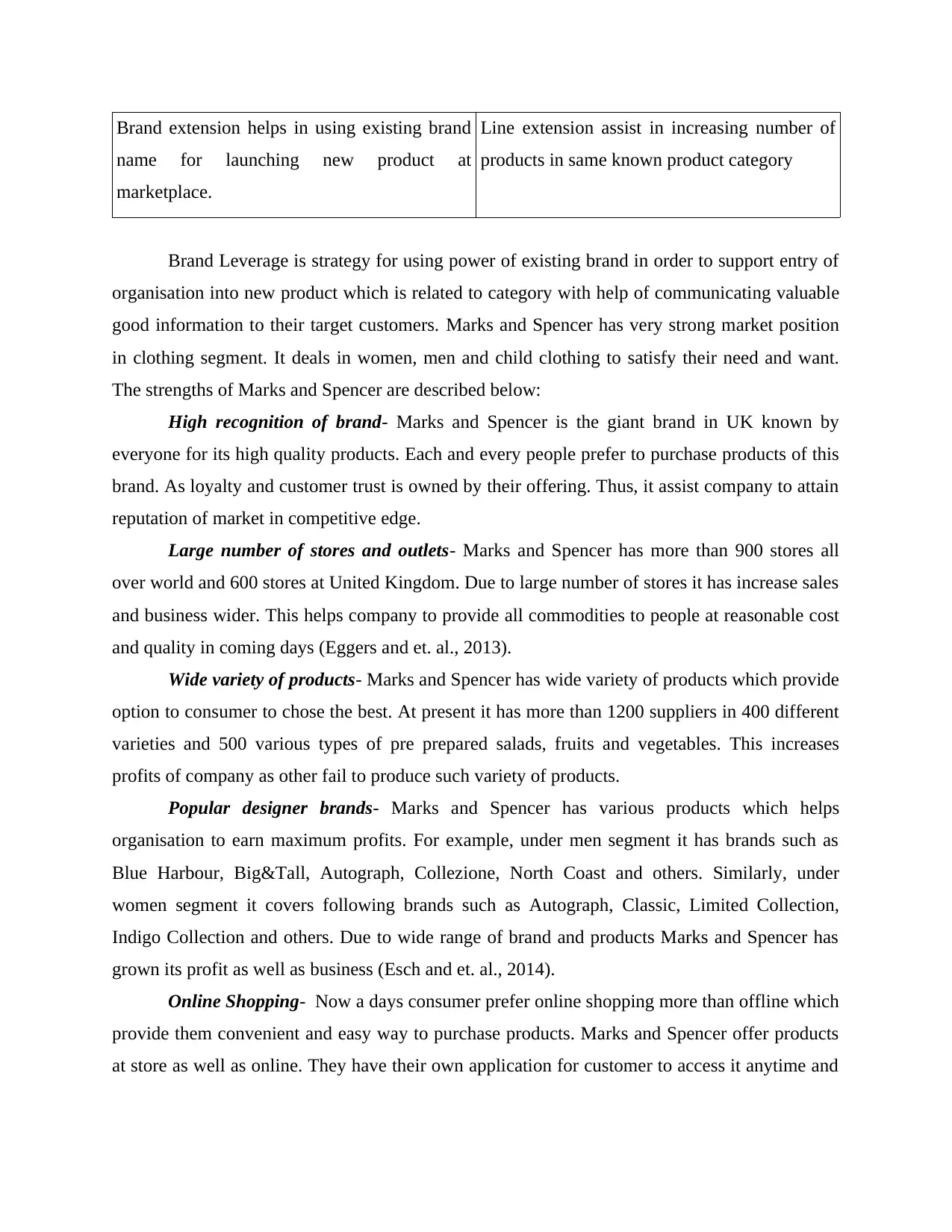
Brand extension helps in using existing brand
name for launching new product at
marketplace.
Line extension assist in increasing number of
products in same known product category
Brand Leverage is strategy for using power of existing brand in order to support entry of
organisation into new product which is related to category with help of communicating valuable
good information to their target customers. Marks and Spencer has very strong market position
in clothing segment. It deals in women, men and child clothing to satisfy their need and want.
The strengths of Marks and Spencer are described below:
High recognition of brand- Marks and Spencer is the giant brand in UK known by
everyone for its high quality products. Each and every people prefer to purchase products of this
brand. As loyalty and customer trust is owned by their offering. Thus, it assist company to attain
reputation of market in competitive edge.
Large number of stores and outlets- Marks and Spencer has more than 900 stores all
over world and 600 stores at United Kingdom. Due to large number of stores it has increase sales
and business wider. This helps company to provide all commodities to people at reasonable cost
and quality in coming days (Eggers and et. al., 2013).
Wide variety of products- Marks and Spencer has wide variety of products which provide
option to consumer to chose the best. At present it has more than 1200 suppliers in 400 different
varieties and 500 various types of pre prepared salads, fruits and vegetables. This increases
profits of company as other fail to produce such variety of products.
Popular designer brands- Marks and Spencer has various products which helps
organisation to earn maximum profits. For example, under men segment it has brands such as
Blue Harbour, Big&Tall, Autograph, Collezione, North Coast and others. Similarly, under
women segment it covers following brands such as Autograph, Classic, Limited Collection,
Indigo Collection and others. Due to wide range of brand and products Marks and Spencer has
grown its profit as well as business (Esch and et. al., 2014).
Online Shopping- Now a days consumer prefer online shopping more than offline which
provide them convenient and easy way to purchase products. Marks and Spencer offer products
at store as well as online. They have their own application for customer to access it anytime and
name for launching new product at
marketplace.
Line extension assist in increasing number of
products in same known product category
Brand Leverage is strategy for using power of existing brand in order to support entry of
organisation into new product which is related to category with help of communicating valuable
good information to their target customers. Marks and Spencer has very strong market position
in clothing segment. It deals in women, men and child clothing to satisfy their need and want.
The strengths of Marks and Spencer are described below:
High recognition of brand- Marks and Spencer is the giant brand in UK known by
everyone for its high quality products. Each and every people prefer to purchase products of this
brand. As loyalty and customer trust is owned by their offering. Thus, it assist company to attain
reputation of market in competitive edge.
Large number of stores and outlets- Marks and Spencer has more than 900 stores all
over world and 600 stores at United Kingdom. Due to large number of stores it has increase sales
and business wider. This helps company to provide all commodities to people at reasonable cost
and quality in coming days (Eggers and et. al., 2013).
Wide variety of products- Marks and Spencer has wide variety of products which provide
option to consumer to chose the best. At present it has more than 1200 suppliers in 400 different
varieties and 500 various types of pre prepared salads, fruits and vegetables. This increases
profits of company as other fail to produce such variety of products.
Popular designer brands- Marks and Spencer has various products which helps
organisation to earn maximum profits. For example, under men segment it has brands such as
Blue Harbour, Big&Tall, Autograph, Collezione, North Coast and others. Similarly, under
women segment it covers following brands such as Autograph, Classic, Limited Collection,
Indigo Collection and others. Due to wide range of brand and products Marks and Spencer has
grown its profit as well as business (Esch and et. al., 2014).
Online Shopping- Now a days consumer prefer online shopping more than offline which
provide them convenient and easy way to purchase products. Marks and Spencer offer products
at store as well as online. They have their own application for customer to access it anytime and
Paraphrase This Document
Need a fresh take? Get an instant paraphrase of this document with our AI Paraphraser
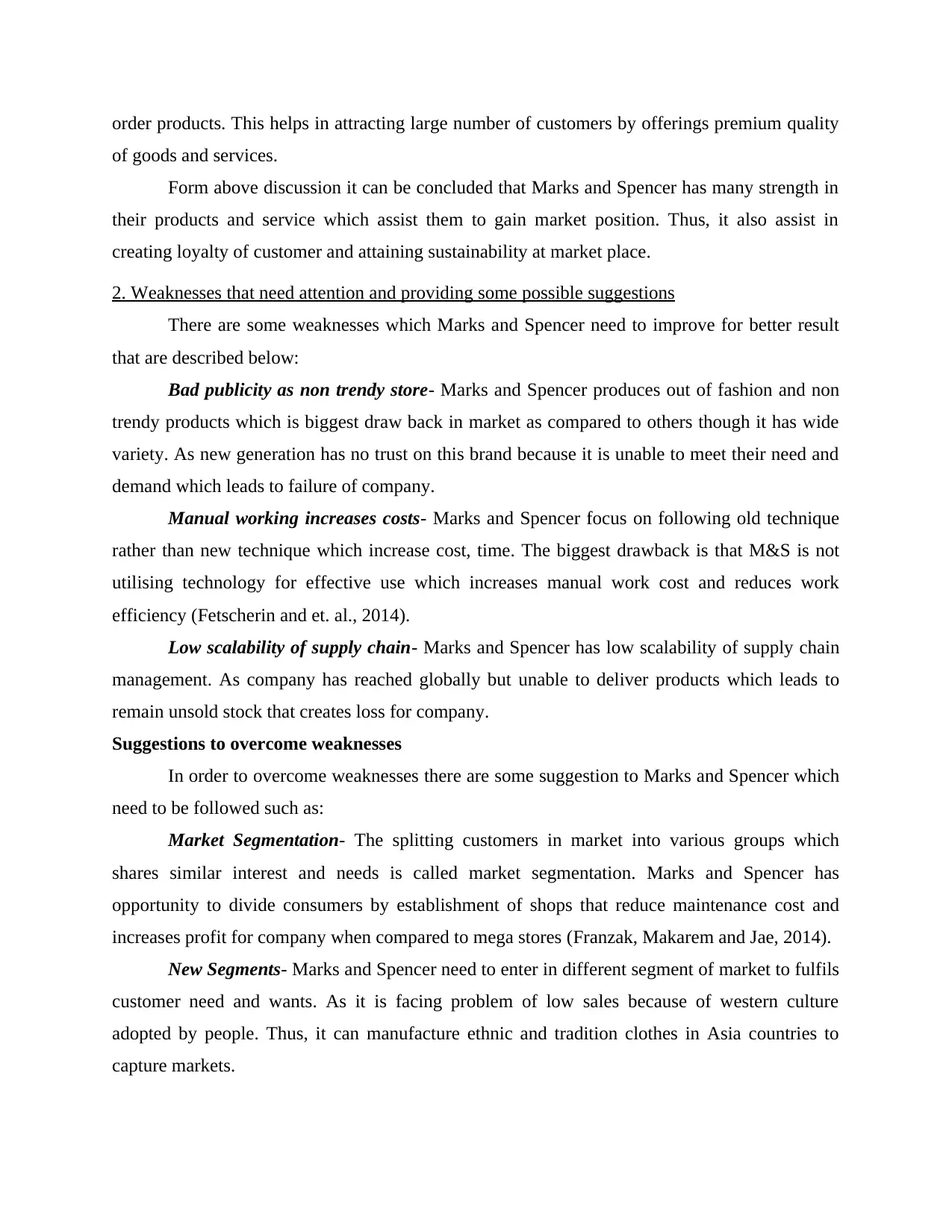
order products. This helps in attracting large number of customers by offerings premium quality
of goods and services.
Form above discussion it can be concluded that Marks and Spencer has many strength in
their products and service which assist them to gain market position. Thus, it also assist in
creating loyalty of customer and attaining sustainability at market place.
2. Weaknesses that need attention and providing some possible suggestions
There are some weaknesses which Marks and Spencer need to improve for better result
that are described below:
Bad publicity as non trendy store- Marks and Spencer produces out of fashion and non
trendy products which is biggest draw back in market as compared to others though it has wide
variety. As new generation has no trust on this brand because it is unable to meet their need and
demand which leads to failure of company.
Manual working increases costs- Marks and Spencer focus on following old technique
rather than new technique which increase cost, time. The biggest drawback is that M&S is not
utilising technology for effective use which increases manual work cost and reduces work
efficiency (Fetscherin and et. al., 2014).
Low scalability of supply chain- Marks and Spencer has low scalability of supply chain
management. As company has reached globally but unable to deliver products which leads to
remain unsold stock that creates loss for company.
Suggestions to overcome weaknesses
In order to overcome weaknesses there are some suggestion to Marks and Spencer which
need to be followed such as:
Market Segmentation- The splitting customers in market into various groups which
shares similar interest and needs is called market segmentation. Marks and Spencer has
opportunity to divide consumers by establishment of shops that reduce maintenance cost and
increases profit for company when compared to mega stores (Franzak, Makarem and Jae, 2014).
New Segments- Marks and Spencer need to enter in different segment of market to fulfils
customer need and wants. As it is facing problem of low sales because of western culture
adopted by people. Thus, it can manufacture ethnic and tradition clothes in Asia countries to
capture markets.
of goods and services.
Form above discussion it can be concluded that Marks and Spencer has many strength in
their products and service which assist them to gain market position. Thus, it also assist in
creating loyalty of customer and attaining sustainability at market place.
2. Weaknesses that need attention and providing some possible suggestions
There are some weaknesses which Marks and Spencer need to improve for better result
that are described below:
Bad publicity as non trendy store- Marks and Spencer produces out of fashion and non
trendy products which is biggest draw back in market as compared to others though it has wide
variety. As new generation has no trust on this brand because it is unable to meet their need and
demand which leads to failure of company.
Manual working increases costs- Marks and Spencer focus on following old technique
rather than new technique which increase cost, time. The biggest drawback is that M&S is not
utilising technology for effective use which increases manual work cost and reduces work
efficiency (Fetscherin and et. al., 2014).
Low scalability of supply chain- Marks and Spencer has low scalability of supply chain
management. As company has reached globally but unable to deliver products which leads to
remain unsold stock that creates loss for company.
Suggestions to overcome weaknesses
In order to overcome weaknesses there are some suggestion to Marks and Spencer which
need to be followed such as:
Market Segmentation- The splitting customers in market into various groups which
shares similar interest and needs is called market segmentation. Marks and Spencer has
opportunity to divide consumers by establishment of shops that reduce maintenance cost and
increases profit for company when compared to mega stores (Franzak, Makarem and Jae, 2014).
New Segments- Marks and Spencer need to enter in different segment of market to fulfils
customer need and wants. As it is facing problem of low sales because of western culture
adopted by people. Thus, it can manufacture ethnic and tradition clothes in Asia countries to
capture markets.
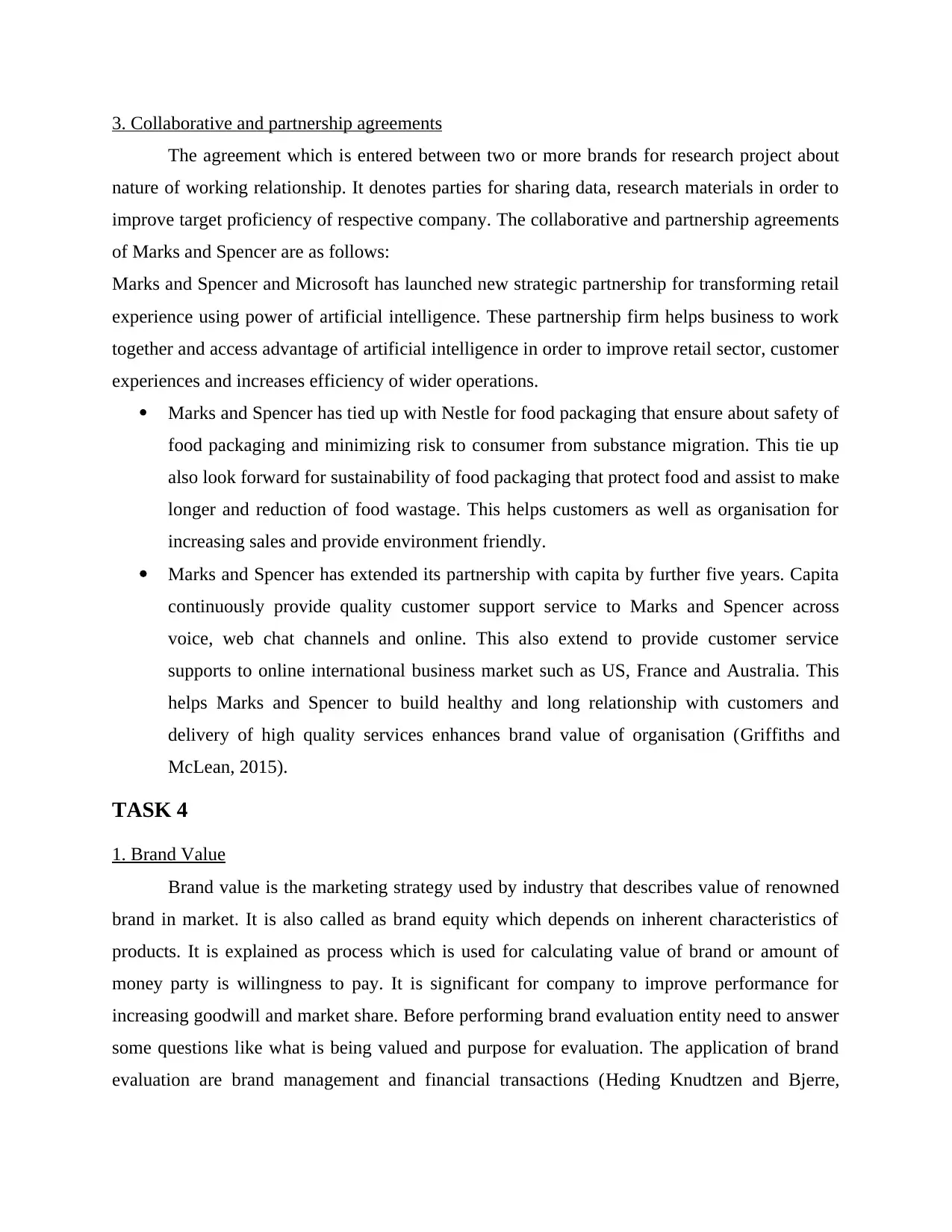
3. Collaborative and partnership agreements
The agreement which is entered between two or more brands for research project about
nature of working relationship. It denotes parties for sharing data, research materials in order to
improve target proficiency of respective company. The collaborative and partnership agreements
of Marks and Spencer are as follows:
Marks and Spencer and Microsoft has launched new strategic partnership for transforming retail
experience using power of artificial intelligence. These partnership firm helps business to work
together and access advantage of artificial intelligence in order to improve retail sector, customer
experiences and increases efficiency of wider operations.
Marks and Spencer has tied up with Nestle for food packaging that ensure about safety of
food packaging and minimizing risk to consumer from substance migration. This tie up
also look forward for sustainability of food packaging that protect food and assist to make
longer and reduction of food wastage. This helps customers as well as organisation for
increasing sales and provide environment friendly.
Marks and Spencer has extended its partnership with capita by further five years. Capita
continuously provide quality customer support service to Marks and Spencer across
voice, web chat channels and online. This also extend to provide customer service
supports to online international business market such as US, France and Australia. This
helps Marks and Spencer to build healthy and long relationship with customers and
delivery of high quality services enhances brand value of organisation (Griffiths and
McLean, 2015).
TASK 4
1. Brand Value
Brand value is the marketing strategy used by industry that describes value of renowned
brand in market. It is also called as brand equity which depends on inherent characteristics of
products. It is explained as process which is used for calculating value of brand or amount of
money party is willingness to pay. It is significant for company to improve performance for
increasing goodwill and market share. Before performing brand evaluation entity need to answer
some questions like what is being valued and purpose for evaluation. The application of brand
evaluation are brand management and financial transactions (Heding Knudtzen and Bjerre,
The agreement which is entered between two or more brands for research project about
nature of working relationship. It denotes parties for sharing data, research materials in order to
improve target proficiency of respective company. The collaborative and partnership agreements
of Marks and Spencer are as follows:
Marks and Spencer and Microsoft has launched new strategic partnership for transforming retail
experience using power of artificial intelligence. These partnership firm helps business to work
together and access advantage of artificial intelligence in order to improve retail sector, customer
experiences and increases efficiency of wider operations.
Marks and Spencer has tied up with Nestle for food packaging that ensure about safety of
food packaging and minimizing risk to consumer from substance migration. This tie up
also look forward for sustainability of food packaging that protect food and assist to make
longer and reduction of food wastage. This helps customers as well as organisation for
increasing sales and provide environment friendly.
Marks and Spencer has extended its partnership with capita by further five years. Capita
continuously provide quality customer support service to Marks and Spencer across
voice, web chat channels and online. This also extend to provide customer service
supports to online international business market such as US, France and Australia. This
helps Marks and Spencer to build healthy and long relationship with customers and
delivery of high quality services enhances brand value of organisation (Griffiths and
McLean, 2015).
TASK 4
1. Brand Value
Brand value is the marketing strategy used by industry that describes value of renowned
brand in market. It is also called as brand equity which depends on inherent characteristics of
products. It is explained as process which is used for calculating value of brand or amount of
money party is willingness to pay. It is significant for company to improve performance for
increasing goodwill and market share. Before performing brand evaluation entity need to answer
some questions like what is being valued and purpose for evaluation. The application of brand
evaluation are brand management and financial transactions (Heding Knudtzen and Bjerre,
⊘ This is a preview!⊘
Do you want full access?
Subscribe today to unlock all pages.

Trusted by 1+ million students worldwide
1 out of 18
Related Documents
Your All-in-One AI-Powered Toolkit for Academic Success.
+13062052269
info@desklib.com
Available 24*7 on WhatsApp / Email
![[object Object]](/_next/static/media/star-bottom.7253800d.svg)
Unlock your academic potential
Copyright © 2020–2025 A2Z Services. All Rights Reserved. Developed and managed by ZUCOL.





